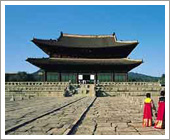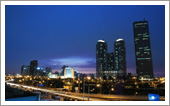South Korea Health Insurance
 |
|

Known to be one of the most linguistically and ethnically homogenous
countries in the world, South Korea – referred to
officially as the Republic of Korea, is perched on the
north-eastern corner of continental Asia, occupying the
southern region of the Korean Peninsula. The country showcases
a varied topography of picturesque mountains, remote,
unspoiled islands, dynamic coastline and white-sand beaches.
Visitors have the chance to develop an appreciation for its
rich cultural tapestry, explore serene temples, royal tombs
and a peek into ancient Confucianism. Described as a country
of endless possibilities, this forward-thinking nation has an
insatiable appetite for technology and dominates many
contemporary fields such as space programs, robotics and
automobiles. According to the Organization for Economic
Co-operation and Development, South Korea has leading rankings
in science, mathematics, problem solving and reading,
confirming the population of 48.8 million (CIA, 2012) has the
world's highest estimated national IQ. Along with the official
Korean language, Chinese, Japanese and English are widely
taught in schools however the latter is rarely spoken outside
the main business and tourist centers.
South Korea Health Care and Insurance
The Ministry for Health, Welfare and Family Affairs (MIHWFA)
has overall responsibility for the country’s heath
system, managing the delivery of health and social services to
residents and undertaking a supervisory role in South
Korea’s health insurance scheme. Known as
‘NHI’, the National Health Insurance system allows
universal coverage for the populace to access
medically-necessary hospital, physician and diagnostic
services. As the country’s single insurer, the National
Health Insurance Corporation is tasked with managing the NHI,
responsible for determining the eligibility of insured
persons, making benefit payments, and assessing and collecting
premiums. Membership to the NHI is mandatory, with employee
and employer contributions calculated at a percentage of
employee wages. The bulk of health system funding is derived
from government subsidies, employer and employee
contributions, private health insurance and co-payments by
users of health services. Out-of-pocket expenses can range
from anywhere between 10-50percent of the cost of treatment,
and as some medical services are not covered under the NHI
plan - including a number of high-tech diagnostic services and
some types of chemotherapy for cancer treatment – many
locals arrange additional private insurance coverage.
Despite the universal healthcare system, state-of-the-art
diagnostic facilities and well-equipped hospitals, public
satisfaction of the health sector is low due to long wait
times and the high cost of treatment. The provision of
healthcare is heavily dominated by private medical providers
according to the Economist Intelligence Unit, with around
90percent of facilities and specialist doctors operating
within for-profit facilities. As patients can choose their
healthcare provider, primary care is often bypassed in favour
of specialists, even for simple ailments, rendering the
public-sector role to providing basic primary-care services.
As the majority of medical establishments are private,
for-profit institutions, minor problems are therefore treated
inefficiently and expensively, contributing to the issue of
increased wait times and compounding the need for additional
comprehensive health insurance to cover the costs associated
with private facilities.
Compared to an average healthcare spend of around 9percent
of GDP by developed countries, according to the Economist
Intelligence Unit, South Korea’s spend is amongst the
lowest in the OECD, although is forecast to increase to
approximately 6.7percent of GDP in 2014. Despite a
consistently low spend, life expectancy has risen steadily in
recent decades and currently stands at an estimated 76 years
for males and 82 years for females (CIA, 2012), lower than
Japan, but comparing favourably with other countries in the
region such as Malaysia, Indonesia and China. Frequently
quoted as an indicator of health care conditions in a country,
the infant mortality rate in South Korea is comparable to the
low levels in other advanced countries at an estimated 4.08
deaths per 1,000 live births (CIA, 2012) ranking South Korea
better than the likes of Australia, the UK and Canada. The
health system however faces a number of challenges, with
pressure mounting due to an increase in chronic disease, a low
birth rate, an aging population and inequity in income
distribution.
South Korea’s ambulatory services are operated by the
fire department; contactable by dialing 119. The service has a
rapid response time; however personnel are not trained in
emergency medicine to the same level of ambulance staff in
other developed countries. Ambulances do not carry
sophisticated equipment but instead deliver patients to the
closest hospital for emergency treatment. A Medical Relief
Programme (MRP) allows for the provision of emergency medical
services to those not covered under the national scheme, such
as foreign workers and the homeless, but is not designed to
replace the need for comprehensive health insurance.
Expatriates and visitors to South Korea who require medical
attention should be prepared to pay treatment costs at the
time of receiving the service.
 |
|
South Korea's medical insurance industry is a fast paced ever evolving market however our staff are experts and at your disposal. |
Expatriates and Travelers in South Korea
|
South Korea Travel Insurance Concerns
Vaccine-preventable diseases such as Hepatitis A & B,
Typhoid and Japanese Encephalitis occur in South Korea,
prompting the US Centre for Disease Control to recommend
inoculations are administered for these diseases before
travel. Routine childhood vaccinations for those not
previously immunized are also recommended.
Natural hazards such as severe rainstorms and typhoons occur
during the monsoon season which typically extends from June
until September. Storms have previously caused flooding and
landslides and resulted in extensive damage to infrastructure
and significant loss of life. The provision of essential
services can also be disrupted, and advisories recommend
expatriates and visitors remain informed of weather forecasts
and follow the advice of local Korean authorities. The safety
of road users is also commonly at risk, mainly due to
excessive speed, running of red lights, weaving motorcycles,
the frequent lane-changing of locals without signaling, and
aggressive bus drivers. These factors have resulted in a
significantly high traffic fatality rate. Accidents involving
pedestrians also occur as marked crosswalks are not
consistently adhered to by drivers and motorcyclists sometimes
ride on sidewalks. Injuries are likely to be treated at a
private medical facility, requiring payment at the time of
service for those not covered under the South Korean health
insurance plan.
Political demonstrations are common in South Korea, where a
modern democracy operates and locals are active in their
political participation. Demonstrations should be avoided
because despite a decrease in the violence previously
associated with such protests, intended peaceful gatherings
have turned confrontational. Travel advisories recommend
exercising caution should one find themselves in an area of
active demonstrations.
Provocative behavior by the country’s North Korean
neighbour has increased tensions on the peninsula, prompting
warnings from developed nations against tourist and
non-essential travel to the North-Western islands and
surrounding waters due to the risk to personal safety. In
November 2010, two people were killed and 16 injured when
North Korean artillery shelled a South Korean island,
resulting in foreign governments advising their own nationals
that similar occurrences cannot be ruled out. A high level of
readiness is maintained by South Korea should a response to
DPRK threats be required. The country regularly conducts
military training exercises throughout the year, including
civil defense drills which are usually held four times each
year. Expatriates and visitors should remain informed through
local media sources regarding upcoming military and defense
drills, which sometimes occur at short notice. Visitors should
ensure they have comprehensive health and travel insurance
which provides coverage for all possible medical
circumstances, including evacuation.
South Korea Expat Health Insurance
Medical facilities in South Korea are of a high quality and
well-equipped. Western-style facilities are available in the
major cities, however the sector is dominated by private
medical providers and the cost of treatment is considerable.
Individuals need to be prepared to pay in full, the cost of
any treatment, unless comprehensive health insurance coverage
is confirmed and an ability to pay established. Cover can be
arranged through International Medical Insurance, which
provides globally transferable policies for whenever and
wherever you may travel. Policies deliver benefits for a range
of medical needs, including emergency evacuation and
repatriation, doctors’ and specialist fees, the cost of
medication and maternity services. To guarantee the cost of
treatment and/or hospitalization in South Korea is not a
financial burden, contact an International Medical Insurance
consultant to discuss your requirements.
|

